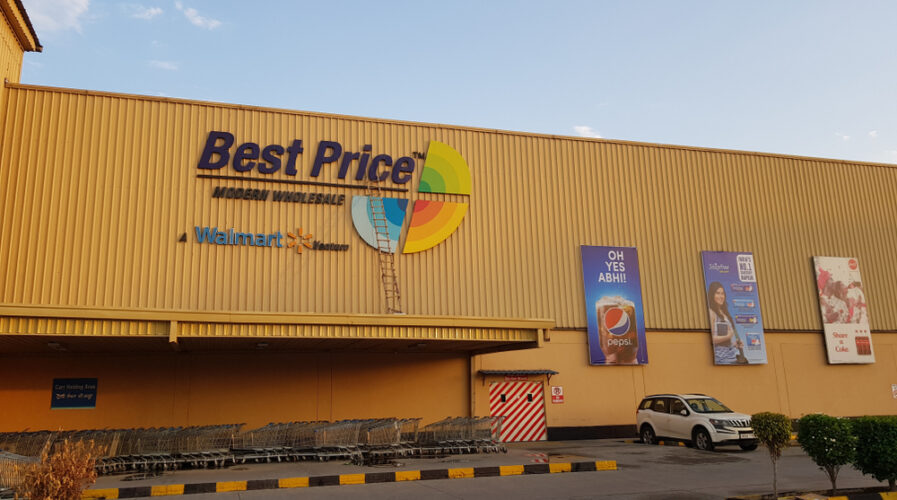
An omnichannel retail strategy can help traditional store chains looking to survive (and thrive) in the new digital-heavy retail reality. Source: Shutterstock
How Walmart India ramped up its omnichannel retail experience
- Walmart’s revenues were up this quarter, driven by the omnichannel strategy adoption
- Despite not making a profit, Walmart’s Indian operations were consolidated and refocused to take on the B2B segment instead
Walmart has just announced its Q2 2020 earnings this week, and it appears that the world’s largest retailer has come out as one of the post-pandemic winners, with strong growth buoyed by its omnichannel retail push over the last few months.
Walmart’s US operations experienced a dramatic surge in online sales, up 97% from the same period last year, while its same-store sales rose 9.3%. Even with the pandemic affecting net sales and operating profits, total revenue was still up by US$10.7 billion to US$134.6 billion, with net sales totaling nearly US$30 billion – still a 3.4% hike over the previous year’s earnings.
With an online sales jump of 74%, it’s clear the decision to forge ahead with an omnichannel retail strategy is paying dividends for Walmart, following coronavirus-related scares that initially caused revenue forecasts for brick-and-mortar retailers to shrink.
“We’re pleased with the progress we’re making on Walmart.com. We had really strong sales growth and significantly reduced losses. The tailwinds we’re experiencing are accelerating our progress to build a healthier e-commerce business as we add new brands, improve product mix, grow the marketplace and achieve more fixed-cost leverage,” said Walmart President and CEO Doug McMillon. “The stores and online merchant teams are now integrated, and we believe we’ll benefit from that change going forward.”
While Walmart International’s operating income was still down by 9.1%, e-commerce contributed at least 12% of the segment’s net sales, led primarily by the firm’s omnichannel capabilities. The dip in operating income came about because of business restructuring charges made this year, as well as the acquisition of Indian e-tailer Flipkart, which the company closed in 2018 for US$16 billion.
“International’s results were better than anticipated coming into the quarter,” commented Walmart EVP and CFO, Brett Biggs. “Despite operational limitations in several markets due to the [coronavirus] crisis, including the government-mandated closure of Flipkart [in India], net sales increased 1.6% in constant currency, including nearly 40% growth in e-commerce.”
Walmart leveraged its scale and supply chain efficiencies to ramp up its e-commerce and food business footprints, bringing them into line with the company’s omnichannel retail thrust even as the COVID-19 crisis interfered with an efficient rollout. But Hari Vasudev, Walmart Global Tech India’s Country Head and SVP of Technology, highlighted to ETCIO the critical role that technology played to bring the omnichannel retail experience to customers who could no longer go physically to stores.
“When customers order through the [mobile] application they can choose to receive the contactless deliveries while checking out through the cart. With this, the driver also gets a notification that this is no contact delivery hence he leaves the items at the front door and steps back,” Vasudev explained. “And because we want to make sure that there is no option of fraud in this service, the drivers are asked to [take a] photo of the delivery items which they upload into the system. We use the same picture to push a notification to the customer that their order is out there and they can receive it.”
Another new option was curbside pickup, currently rolled out in 5,200 stores throughout the US. Leveraging on the company’s existing store-to-doorstep pharmacy delivery mechanism, Walmart added a new option for customers to elect to pick up their orders from a designated pick up point, bypassing going into the store altogether. “So, we are putting a bunch of technologies in place that allows us to do appropriate bifurcation of the orders which helps us do the curbside with in-store sales,” said Vasudev.
“Likewise, when it comes to delivering at customers’ doorsteps, we are putting solutions which allow us to do better round optimization. With this, our drivers are able to deliver more orders to customer’s home in the time when the customer orders have spiked.”
Taking into consideration the social distancing regulations for physical stores, the chain has made changes to its in-store experience to minimize potential infection too. “We had rolled out scan-and-go implementation in all of our stores. Because of COVID-19, we have fine-tuned this implementation and scaled it up in some areas. It takes a lot to perfect any technology and scale it up,” Vasudev added. “But what our technology teams have done is commendable. A lot of work has been happening out of the India Development Centre in Bangalore and Chennai. We are making sure that we are able to deliver seamless customer experience when they need it.”
As for Flipkart, Walmart’s majority-owned subsidiary in India, the local government prohibited Flipkart from operating for a while during Q2 2020, causing the lack of growth of its international operations. However, Flipkart strengthened its presence in the B2B market by acquiring Walmart India from parent company Walmart.
Walmart India was operating the Best Price cash-and-carry business, which Flipkart rebranded as Flipkart Wholesale, a digital marketplace that is looking to digitally transform the smaller retailers and mom-and-pop sellers (known as ‘kiranas’ in India) and to consolidate them under the Flipkart Wholesale platform.
“Kiranas and MSMEs [micro small medium enterprises] are central to India’s retail ecosystem and Flipkart Wholesale will focus on meeting their needs by providing small businesses a wide selection at significant value, powered by technology to make their lives easier,” Flipkart said in a statement last month, announcing the buyout.
READ MORE
- Ethical AI: The renewed importance of safeguarding data and customer privacy in Generative AI applications
- How Japan balances AI-driven opportunities with cybersecurity needs
- Deploying SASE: Benchmarking your approach
- Insurance everywhere all at once: the digital transformation of the APAC insurance industry
- Google parent Alphabet eyes HubSpot: A potential acquisition shaping the future of CRM


